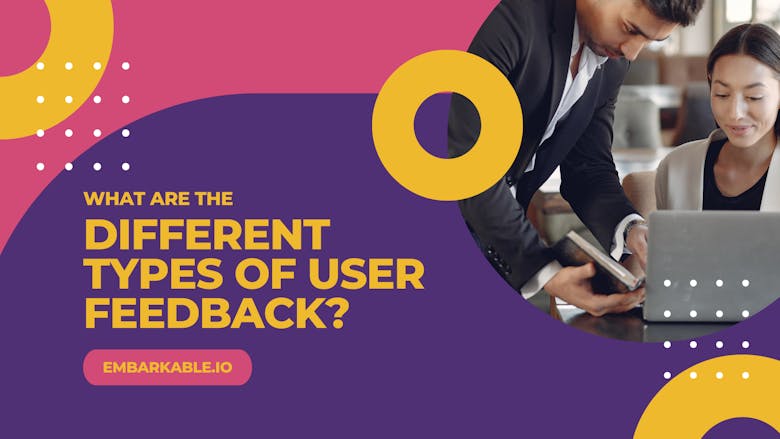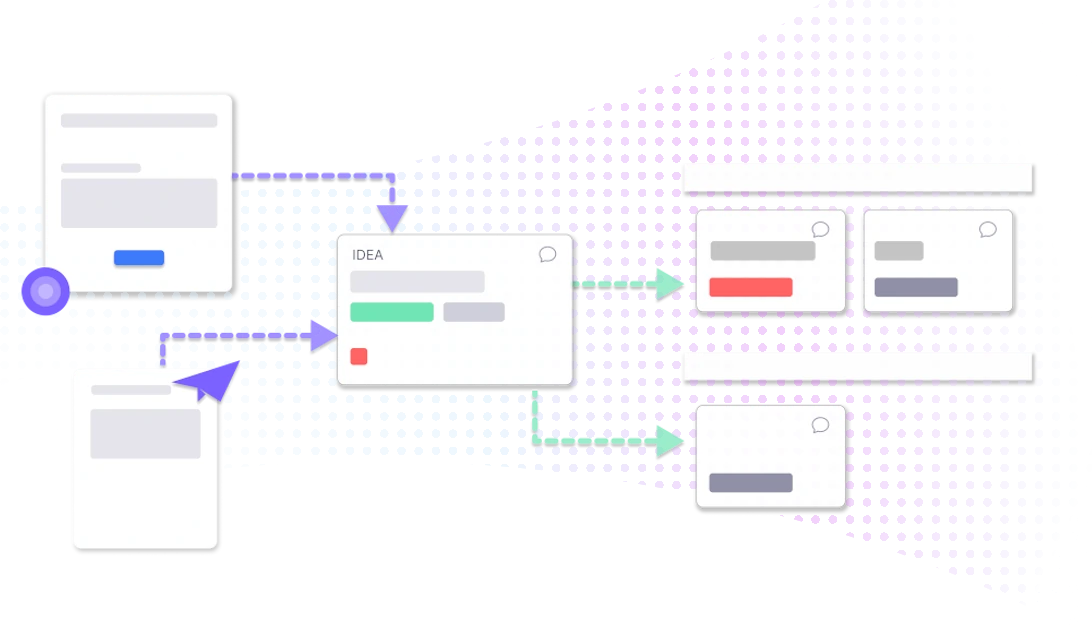What Are The Different Types Of User Feedback?

User feedback is a critical component of product development, design, and user experience. We'll discuss the different types of collecting user feedback, as well as the types of customer feedback that you will collect.
Types of customer feedback: Collection Feedback Passively
Passive feedback is feedback you get without asking. These typically come in through your support channels, or during sales calls. You're probably already getting a lot of passive feedback - customers love to tell you what they think! Let's go through those first.
Support Interactions
There is a huge wealth of information inside your support tickets. Extracting the feedback involves reading through all of the tickets that have been submitted, and distilling the feedback that's hidden within them.
To do this, you'll need to be able to spot the clues that indicate customer feedback. These clues can include things like complaints about a certain feature, requests for help with a specific issue, or expressions of gratitude for the support that's been provided. By reading through the tickets, you can get a sense of what areas need improvement without having to ask the customer directly. For example, if a customer writes "I don't know how to do this" or "I don't understand this," they may be asking for help with the feature.
Reviews on public sites
Publicly accessible online review sites provide a platform for customers to share their experiences with businesses, products, or services. This can include posting a rating and/or writing a review. The reviews on these sites are typically public and can be viewed by anyone. They are often used as a resource by consumers when researching a purchase, but they are also a valuable resource for the product owner to get an unfiltered opinion of the product.
In order to leverage reviews for your product, you'll want to find out where people are leaving them. This will depend on your niche - for example, Capterra is a site for software reviews, and Yelp is a site for food reviews. Once you know where people are leaving reviews, you'll want to start monitoring them. If you can, respond to the reviews publicly. This shows that you're engaged with your customers and that you care about their feedback. Responding to both good and bad reviews helps show that you're taking the time to address all of the feedback that you receive.
Types of customer feedback: Collect Feedback Actively
The benefits of collecting feedback actively are that you can get feedback more quickly, and you can target specific customers who might be more likely to provide useful feedback. It can also help build stronger customer relationships, since customers feel like they're being heard and that their opinions matter.
Surveys
A survey is a simple way to collect user feedback. Keep in mind that users may not be able to complete a long survey, so generally it's best to make it as brief as possible.
Surveys are a great way to get feedback on specific areas of your product. It's the best way to get a feel for what percentage of your users feel a certain way They can be sent out through email, or conducted within your app. Make sure to include free response questions so you can hear feedback in users own words.
Put simply, a survey is basically asking questions to your users. There are a few common survey formats, including, NPS, CSAT, and exit or churn surveys.
User Interviews
User interviews are typically one-to-one interviews where a research expert conducts an interview with a member of your target audience. They are one-on-one, and take place in person, over a video call, or by telephone. These interviews are the most valuable source of qualitative feedback and can complement many other methods.
Before conducting a user interview, it is necessary to know what your overall goal is. A broad goal could result in a poorly-conducted interview. Instead, set concrete goals for the interview that will direct the content of questions and help focus the conversation. You may even want to write a script for yourself to make sure you ask similar questions to each interviewee.
While conducting a user interview, it is important to make the process as comfortable and enjoyable as possible. It is important to maintain a friendly, non-judgmental environment where the interviewee can freely express their views and feelings. Interviewers should be courteous and make eye contact with the interviewee, and don't hesitate to nod in agreement. Don't rush the interview, as this can make the participant feel unappreciated and rushed. To increase the level of engagement, you can offer greater incentives if participants agree to participate for longer.
A user interview can be conducted during many stages of a user research project. From ideation to concept development to testing, user interviews are an invaluable tool to gather valuable information from real people about the experience using your product. Interviews are often conducted with multiple users and follow a specific methodology. To capitalize on the results, follow up on the data after the interview.
Types of customer feedback
Now that we've discussed the ways to collect customer feedback, we'll talk about the different customer feedback types you've just collected.
Feature requests
Feature requests are suggestions for improvements to a product. Typically, these requests arise because of a customer's pain point and can be collected in a number of ways. By implementing the features that customers request, product owners can better serve their customers and improve the quality of their product.
You're probably getting feature requests via your support emails, but you can ask for suggestions via surveys as well. If asking for this type of feedback, make sure to use a feature request template. This will help you define the specific information that you need to collect and organize your feature suggestions. If you use a feature suggestion template, you can guide the feedback and avoid the problem of negativity that can flood your feedback box.
Bug reports
Bug reports are reports of defects that users find in an app.
One one of the most challenging aspects of bug reporting is being able to reproduce the bug, which is key to fixing it. If a user is submitting a bug report via your support channel, or chat, it is unlikely that the user will have provided specific instructions to reproduce the bug. In fact, in order to properly determine the steps needed to reproduce a bug, the user would need to retrace their steps and try troubleshooting different scenarios to see where the bug pops up. While a few of your users may go to the trouble of doing this, it's very unlikely but someone will write in with this level of detail. More than likely, they are just very frustrated that they couldn't use your product the way they needed to.
Because a well-written bug report is needed give the development team detailed information about the problem, consider using a dedicated bug collection tool. These tools will contain information about the browser, operating system, a stack trace, and sometimes even screenshots or video.
Insights into Problems and Friction
Feedback into problem or friction areas of your app often comes in the form of indirect feedback. This can take place when an individual isn't indicating that they are having a problem—they are asking how to perform the action. Paying attention, and identifying this type of feedback will help identify areas where you need to focus efforts to improve the usability of the product.
Some of the most common sources of friction are:
- Confusing or inconsistent UI design
- Slow or unresponsive user interface
- Complicated workflows
- Needing to remember too many steps or complex sequences
- Inability to complete tasks in a single action
- Having to enter the same information multiple times
- Unexpected results or errors
It's also important to understand the sources of problems. If needed, follow up with the customer to clarify why and what they are trying to achieve.
Praise
Let's not forget a really important type of feedback - positive user feedback! Positive feedback is a powerful motivator for any business. It can encourage employees to keep up the good work and provide the motivation to improve on what they are doing. Sharing positive feedback amongst the team will give everyone a sense of accomplishment and pride in your work. This will encourage them to do their best and make them feel good about the job that they are doing.
Encourage these customers to leave reviews. This can be done by providing a link to where they can write a review, or by sending them an email after they have made a purchase thanking them for their business and inviting them to leave feedback. Finally, it is important to respond to any negative reviews in a timely and professional manner. Addressing any complaints or concerns raised by customers can help turn around a bad review and improve customer satisfaction overall.
Positive online reviews help to increase the visibility of a product, attract new customers, and boost sales. If you have customer who has identified themselves as an evangelist, take advantage of it!
What to do with all this feedback?
Creating a system to collect customer feedback, track, and respond to them is essential to the success of any SaaS product. A well-designed feedback process allows businesses to manage the volume and quality of feature requests.
Product managers should capture and organize feature requests from various sources and enter them into a single tool, such as a spreadsheet. This will help ensure that all requested features are accounted for and that the product owner can easily track which features have been requested and by whom. Additionally, it will help keep the product development process organized and streamlined.
Feedback can be a hassle to manage. You might have a document with a list of all the features your product needs, or you might track them in a spreadsheet. But this can be difficult to manage and keep up-to-date. A dedicated tool can make managing feature requests much easier. Check out our list of tools that can help you manage and centralize feedback.
With a tool specifically for managing feedback, you can track customer feedback, comments, and suggestions. A good tool should also allow you to group feedback into clusters, and see who made the feedback. Having all this information in one place will also make it easier for your team to collaborate on requests
This information can help you make better decisions about your business and improve customer satisfaction. You can also prioritize requests and easily see which ones are the most important to your users. This can help you make better decisions about which features to work on next.
Embarkable: Turn feedback into action

Embarkable is a product management platform that connects customer feedback to product goals to help you decide what to build, and why. It lets you consolidate feedback from many different sources so that you'll have more confidence in what to build, and a stronger understanding of your customer needs. Spend less time searching for the right insight, more time building the feature that makes the customer happy, and drive your business forward.
In addition to building roadmaps and managing product launches, Embarkable allows you to monitor a single stream of incoming feedback to keep a pulse on what users are saying - something that would be much too time consuming to do manually. When you have different team members handling support or social media, Embarkable offers peace of mind because you'll know that critical feedback isn't falling through the cracks.